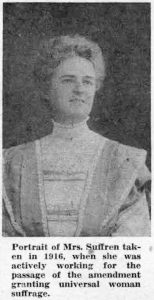 Mrs. Martha Wentworth Suffren, of Strafford, has never missed voting at an election since the 19th Amendment to the U.S. Constitution was ratified on August 26, 1920. This was the memorable amendment which read, “The right of citizens of the United States to vote shall not be denied or abridged by the United States, or by any state on account of sex.” It was an amendment for which no woman had worked harder than had Mrs. Suffren. And once the right to vote had been granted to her sex, she has consistently availed herself of its privilege.
Mrs. Martha Wentworth Suffren, of Strafford, has never missed voting at an election since the 19th Amendment to the U.S. Constitution was ratified on August 26, 1920. This was the memorable amendment which read, “The right of citizens of the United States to vote shall not be denied or abridged by the United States, or by any state on account of sex.” It was an amendment for which no woman had worked harder than had Mrs. Suffren. And once the right to vote had been granted to her sex, she has consistently availed herself of its privilege.
More than 100 years ago, in July, 1848, the first Women’s Rights convention in all history was held at the home of Mrs. Elizabeth Cady Stanton in Seneca Falls, N.Y., later adjourning to Rochester. It was a meeting called jointly by Mrs. Stanton and by Mrs. Lucretia Mott, one of Radnor township’s early settlers. This may be regarded as the beginning of the movement for woman suffrage, not only in the United States, but in the world.
Two years later this meeting was followed by a convention in Worcester, Mass., under the auspices of Lucy Stone and a distinguished group of suffragists. Then, in 1851, Susan B. Anthony with her dynamic force of personality joined her efforts with those of Mrs. Stanton in a crusade which lasted more than 50 years. After the deaths of these two women, their work was carried on by their successors in office, Dr. Anna Howard Shaw and Mrs. Carrie Chapman Catt.
While living in Brooklyn in the early years of the 20th century, Mrs. Suffren became very active in the work of the Woman’s Suffrage Party in New York City. It was through their mutual interest in this movement that she and Mrs. Catt first formed the friendship that was to last for so many years. When Mrs. Catt became chairman of the Woman’s Suffrage Party of New York City, Mrs. Suffren was first her secretary, later her vice-chairman. The work which Mrs. Suffren accomplished during this period, she now calls the most important thing that she ever did in her life. Frequent were the trips she made to the State Capitol in Albany before 1917, when New York State, by a majority exceeding 100,000, voted for full suffrage to women. It was only three years later, in 1920, that complete and universal woman suffrage was the law of the land.
It was in this year that Mrs. Suffren returned to Strafford from New York to take up her residence again in the stately house on Homestead road which she and her husband had built in 1908. It is from this house that this remarkable woman, now 97 years of age, ventures forth to cast her vote every election day since woman’s suffrage was granted.
In a recent letter received by the writer from Mrs. Suffren, the latter urges that women consider the words of Mrs. Catt in the last speech the latter made to the League of Women Voters when she said, “Women must unite in something greater than national or race loyalty and that is – the motherhood of the wide world.” To this Mrs. Suffren adds her own word when she writes, “Women in governmental office were never more needed than now, with such matters as juvenile delinquency, narcotics, etc., the problems that they are.”
